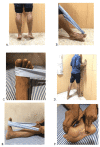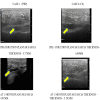A Prospective Study Comparing the Efficacy of Local Injection of Platelet-Rich Plasma (PRP) vs Methylprednisolone in Plantar Fasciitis
- PMID: 35800843
- PMCID: PMC9246436
- DOI: 10.7759/cureus.25523
A Prospective Study Comparing the Efficacy of Local Injection of Platelet-Rich Plasma (PRP) vs Methylprednisolone in Plantar Fasciitis
Abstract
Introduction Plantar fasciitis is a common musculoskeletal problem in Orthopaedic practice. Heel pain caused due to plantar fasciitis, if persistent, can cause distress to the patient, so the correct intervention at the right time is needed. Plantar fasciitis is also common in the rural population. Objectives To compare the efficacy of local injection of platelet-rich plasma (PRP) and corticosteroid (CS) (methylprednisolone) in patients with chronic plantar fasciitis, and to evaluate the safety, side effect and complications of two different modalities of treatment. Materials and methods The study period was between August 2018 and September 2020. After obtaining proper written consent, 110 patients, who were above the age of 18 years and suffering from plantar fasciitis for more than three months, were included in the study. The patient characteristics including gender, age, weight, history of heel pain, duration of symptoms and types of prior treatment were noted. All the 110 patients were subjected to four parameter assessments before administration of the PRP/CS injections. Out of the 110 patients, 55 patients received PRP injection and 55 received CS - 2 ml (40 mg) methylprednisolone with 2 ml of sterile water injections. Post administration of injections, the patients' clinical, radiological, subjective and functional outcomes were assessed at the first, third and sixth month by using the Visual Analog Scale (VAS), Foot and Ankle Outcome Instrument Core Scale (FAI), Roles and Maudsley Scores (RMS), American Orthopaedic Foot and Ankle Society (AOFAS) ankle-hind foot scale and ultrasonogram of plantar fascia thickness. Discussion In this study, 110 patients were screened and evaluated. Out of these 110 patients, five patients who received PRP and five who received CS were lost for follow-up. Out of the 110 patients, 59 were females and 41 were males. The majority of the patients were in the BMI range of 18.5 to 24.9, with a mean BMI of 23.6. Comparing the results in both the groups reflected an improvement in the group of patients who received PRP injections. Two patients had post-operative complications (superficial infection) in the PRP injection group, while 10 patients had post-procedure complications (five patients developed superficial infections, three patients developed skin depigmentation, and two patients had atrophy of fat pad) in the corticosteroid injections (CSI) group. Infections subsided in all the patients as observed during subsequent follow-up. Conclusion This study shows that PRP administration is a good method of managing patients suffering from chronic plantar fasciitis, presenting with some discomfort following activity, with more than three months of symptoms and with a VAS score of more than 6 and plantar fascia thickness of 5 mm and failed conservative management. This is evidenced by a comparison of AOFAS, FAI score and thickness of plantar fascia using an ultrasonogram before and after the procedure. This study reflects better treatment outcomes with PRP injection compared to local steroid infiltration. This is the largest series of cases studied compared to other previously available studies in the literature. PRP injections may thus be used as a superior alternative to the already available treatments for chronic heel pain.
Keywords: local injection; methyl prednisolone; plantar fasciitis; platelet-rich plasma; prospective study.
Copyright © 2022, Vellingiri et al.
Conflict of interest statement
The authors have declared that no competing interests exist.
Figures







References
-
- Comparison of plantar fasciitis injected with platelet-rich plasma vs corticosteroids. Jain SK, Suprashant K, Kumar S, Yadav A, Kearns SR. Foot Ankle Int. 2018;39:780–786. - PubMed
-
- Injected corticosteroids for treating plantar heel pain in adults. David JA, Sankarapandian V, Christopher PR, Chatterjee A, Macaden AS. https://pubmed.ncbi.nlm.nih.gov/28602048/ Cochrane Database Syst Rev. 2017;6:0. - PMC - PubMed
-
- A systematic review and meta-analysis of platelet-rich plasma versus corticosteroid injections for plantar fasciopathy. Singh P, Madanipour S, Bhamra JS, Gill I. Int Orthop. 2017;41:1169–1181. - PubMed
-
- Plantar fasciitis - a comparison of treatment with intralesional steroids versus platelet-rich plasma. A randomized, blinded study. Acosta-Olivo C, Elizondo-Rodriguez J, Lopez-Cavazos R, Vilchez-Cavazos F, Simental-Mendia M, Mendoza-Lemus O. J Am Podiatr Med Assoc. 2017;107:490–496. - PubMed
LinkOut - more resources
Full Text Sources
Research Materials
